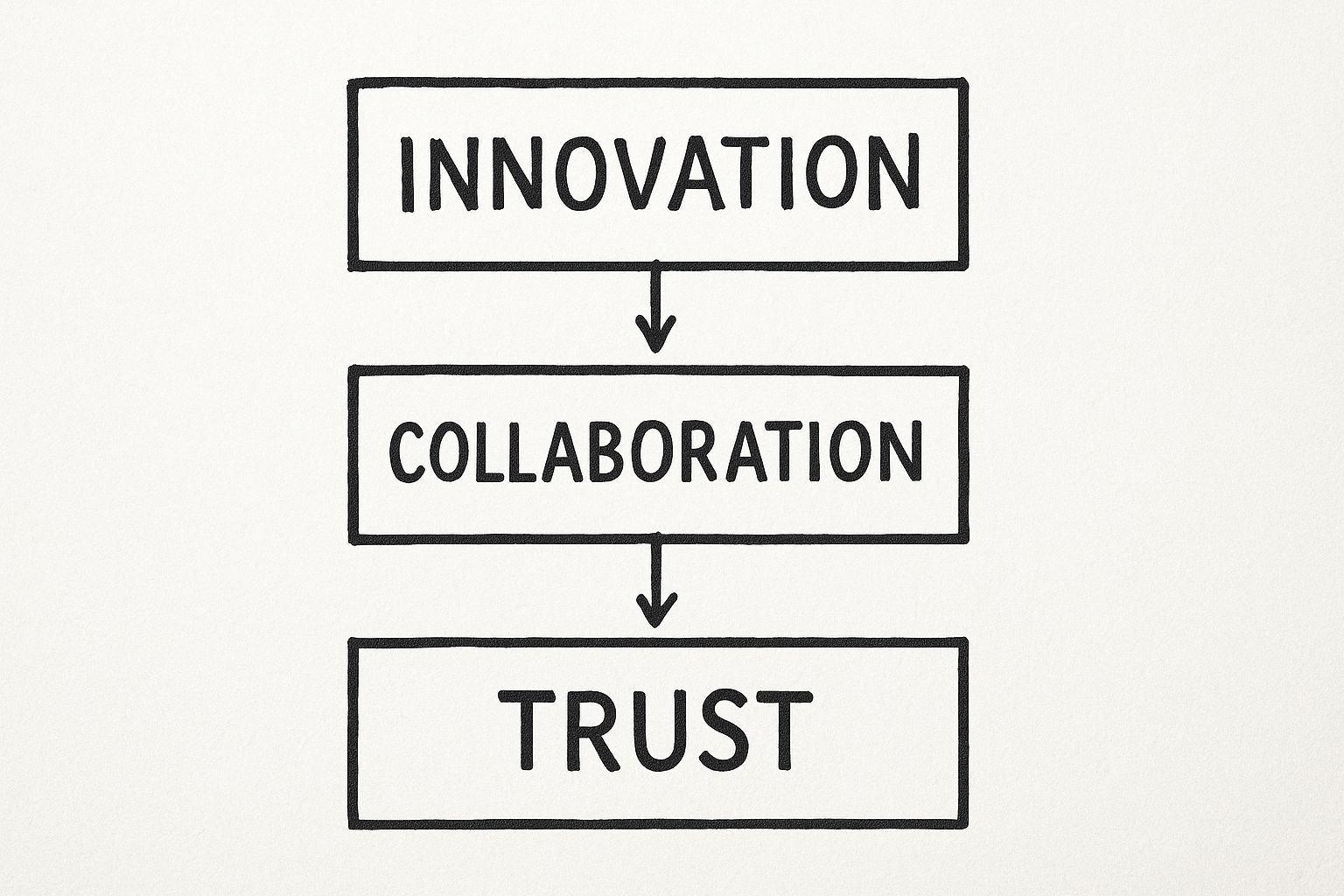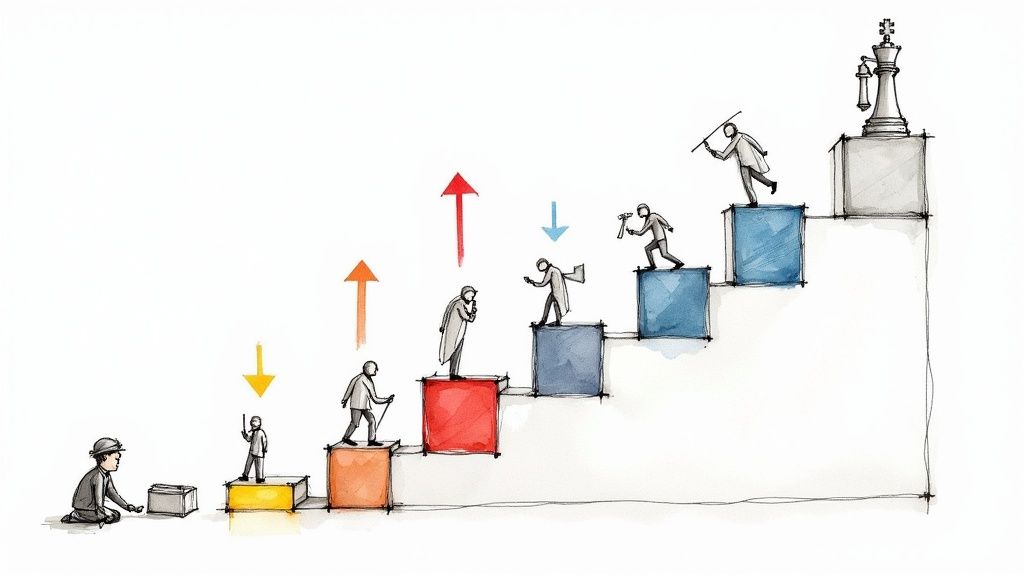Table of Contents
Why Yesterday's Code Heroes Become Tomorrow's Failed Leaders
Thinking Like A Chess Master: Strategic Vision Beyond Code
Making Complex Tech Simple Without Dumbing It Down
Building Teams That Actually Want To Work Together
Making Smart Calls When Nothing Is Certain
Leading Without The Official Title Or Authority
Why Yesterday's Code Heroes Become Tomorrow's Failed Leaders

This image from the World Economic Forum illustrates how the professional world is constantly changing. It really drives home the point that we all need to adapt and pick up new skills to stay ahead of the curve. Knowing your code inside and out just isn't enough anymore.
Picture this: your company's star coder, the one who debugs in their sleep, gets promoted to Tech Lead. Fast forward a few weeks, and their team is unhappy, projects are delayed, and everything's a mess. What went wrong? Their technical brilliance didn't translate into technical leadership. Leading a team requires a whole different skill set than mastering a programming language. It's like navigating a social maze as well as a technical one.
Highly skilled developers often get promoted because of their individual achievements. But leadership is less about what you produce and more about how you help your team perform. This shift demands strong communication, empathy, and the ability to motivate and inspire. Imagine a technically gifted leader making key decisions about the system design all on their own. Their team feels left out and unappreciated, and the project suffers.
This gap between technical skills and leadership ability is becoming more obvious, especially now with remote work, Agile methods, and AI-powered tools. These trends highlight the importance of collaboration, adaptability, and communication. In fact, leadership and social skills are quickly becoming essential. The World Economic Forum’s Future of Jobs Report 2025 states that 39% of core skills will likely change by 2030. Leadership and social influence will see a 22 percentage-point jump in importance compared to 2023. You can find more about this change here. Also, if you want to boost your online presence, check out these LinkedIn profile tips to attract recruiters and expand your network.
Ready to drive more growth & achieve bigger impact?
Leverage my 25+ years of successes and failures to unlock your growth and achieve results you never thought possible.
Get StartedMoving from a purely technical role to a leadership one requires a deliberate focus on developing these "soft" skills. It's about understanding what makes your team tick, what challenges they face, and how to create a positive and productive environment. This means actively listening, offering constructive feedback, and building trust. Tomorrow's successful tech leaders need to be as good at managing people as they are at managing code. They must become mentors, coaches, and strategists, guiding their teams toward common goals.
Thinking Like A Chess Master: Strategic Vision Beyond Code

This infographic neatly illustrates how trust, collaboration, and innovation build upon each other. Trust is the bedrock, the solid foundation upon which a team can truly collaborate. And it's from that collaborative environment that real innovation springs forth.
Effective technical leadership is about much more than just clean code; it's about thinking strategically. Imagine a chess grandmaster. They're not just thinking about the next move, they're thinking several moves ahead, anticipating their opponent's reactions and planning their own counter-strategies. Similarly, a good technical leader thinks about how today's decisions will affect the project in six months, a year, or even further down the line. This isn't about having a crystal ball, but about developing strategic foresight.
One key element of strategic vision is recognizing technical debt. This goes beyond messy or inefficient code. It's about truly understanding the long-term consequences of taking shortcuts. Think about choosing a quick-and-dirty solution to meet a deadline. Sure, it might feel like a win in the moment, but down the road, it can mean a lot of rework, added complexity, and slower development speeds. A strategic leader anticipates these kinds of hidden costs.
Another critical skill is the ability to assess new technologies with a level head. It's easy to get caught up in the excitement of the latest, greatest framework or tool. But a strategic technical leader takes a step back and considers the bigger picture. Will this hot new technology become a maintenance headache in the future? How well will it integrate with our current systems? These are the questions a strategic thinker asks.
Strategic thinking comes together in the creation of a solid technical roadmap. This roadmap isn't just a wish list of features; it's a strategic plan that connects technical choices to the overall business goals. It involves anticipating potential obstacles, pinpointing important milestones, and making sure the team has the resources and support to succeed. This also includes getting buy-in from stakeholders and keeping the team motivated throughout the project. You can learn more about managing organizational change in our article about leadership in change management.
Let's say a company is moving its platform to the cloud. A tactical approach might just focus on the technical parts of the migration. But a strategic leader considers the business implications too, like potential downtime, data security, and how the move will affect customers. They'd create a complete migration strategy that minimizes disruptions and maximizes the long-term advantages. By anticipating challenges and planning carefully, strategic leaders ensure that technical decisions contribute to the overall success of the organization. Through effective planning and foresight, they turn technical hurdles into opportunities for growth and innovation.
To further illustrate the difference between tactical and strategic leadership, let's look at a comparison table:
The following table, "Strategic Leadership Competencies Comparison," outlines the differences between tactical and strategic approaches across key decision-making areas, highlighting their respective long-term impacts.
| Decision Area | Tactical Approach | Strategic Approach | Long-term Impact |
|---|---|---|---|
| Technology Adoption | Focuses on immediate needs and readily available solutions. | Considers long-term integration, scalability, and maintenance. | Tactical can lead to technical debt and integration issues, while strategic promotes sustainable growth. |
| Resource Allocation | Assigns resources based on current project demands. | Aligns resources with long-term strategic goals and anticipates future needs. | Tactical can lead to resource bottlenecks and project delays, while strategic optimizes resource utilization for sustained progress. |
| Risk Management | Addresses immediate risks and reacts to problems as they arise. | Proactively identifies potential risks and develops mitigation strategies. | Tactical can result in unexpected crises and costly fixes, whereas strategic minimizes disruptions and ensures long-term stability. |
| Team Development | Focuses on individual skill development for current projects. | Invests in team growth and fosters a culture of continuous learning to meet future challenges. | Tactical may limit the team's adaptability to new technologies and methodologies, whereas strategic cultivates a highly adaptable and future-ready team. |
As you can see, while a tactical approach might offer quick wins in the short term, a strategic approach builds a foundation for long-term success and resilience.
Making Complex Tech Simple Without Dumbing It Down
Ever sat through a tech talk and felt completely lost, despite the speaker's obvious brilliance? It's like they're speaking a different language, full of jargon and diagrams that make your head spin. This highlights a key skill for tech leaders: translating complex ideas into plain English. It's not about simplifying; it's about communicating effectively with different audiences. Think of it as building a bridge between the technical world and everyone else.
The first step to clear communication is understanding who you're talking to. Are they engineers, product managers, or executives? Each group has different priorities and levels of technical knowledge. Imagine explaining a new system design. With engineers, you'd dive into the nitty-gritty details. But with executives, you'd focus on the big picture – how it improves the business, saves money, or makes customers happier.
There are some handy frameworks to help tailor your message. One is the "What, So What, Now What" approach. "What" describes the technical issue or solution. "So What" explains its importance to the listener. "Now What" outlines the next steps. This simple structure makes your message clear, concise, and actionable.
Another helpful framework is "Problem-Solution-Benefit." Clearly state the problem, then present your technical solution. Finally, highlight the benefits, emphasizing the positive impact on your audience. This helps stakeholders see the value of your work and how it aligns with their goals.
Technical concepts can be abstract and hard to grasp. Storytelling and visuals can bring them to life. Instead of just listing features, tell a story about how your new platform solves a real user problem. Use diagrams and charts to illustrate complex systems, making them easier to digest.
Effective tech leadership also involves understanding how to influence decisions. Instead of dictating solutions, try guiding people with insightful questions. This encourages collaboration and buy-in. For example, instead of saying, "We must refactor this code," you could ask, "What are the long-term risks of not refactoring, and how might that affect our ability to add new features?"
Building consensus is crucial, too. This doesn't mean endless meetings. It means creating opportunities for feedback and discussion. Good tech leaders actively seek input from different perspectives and incorporate it into their decision-making. This builds trust and strengthens the team. This is especially important because strong tech leadership has a ripple effect on the entire organization. It fuels innovation, speeds up product development, and boosts efficiency. A 2025 study by Lumenalta on essential IT leadership skills found that tech leaders who are good communicators help their companies get products to market faster and see better returns on investment. You can find more on this at essential IT leadership skills. Communicating effectively isn't just about conveying information; it's about building relationships, earning trust, and inspiring others to embrace technical solutions. By mastering these skills, tech leaders can transform technical discussions into collaborative problem-solving sessions, resulting in better outcomes for everyone.
Building Teams That Actually Want To Work Together

Building a high-performing technical team isn't about assembling a group of rockstar coders and hoping for the best. It's more like conducting a jazz ensemble. Each musician needs individual skill, but the real magic happens when they improvise together, seamlessly.
Software teams need that same balance of individual brilliance and collaborative harmony. The challenge? Unlike musicians, your team members have diverse coding styles, experience levels, and, let's be honest, strong opinions. This is where technical leadership comes in—shaping these diverse elements into a cohesive, productive unit. Great technical leaders cultivate an environment where differences strengthen the team, not fracture it.
The most effective technical leaders prioritize psychological safety. Think of it as a safety net for innovation. It's about creating a space where team members can take risks, experiment, and even admit mistakes without fear of judgment.
When people feel safe, they're more likely to share their best ideas, challenge assumptions, and push boundaries. This open environment fosters creativity and helps catch potential problems early on, before they become major headaches.
Code reviews can easily turn into nitpicking contests. But with the right leadership, they become valuable opportunities for growth and knowledge sharing.
Good technical leaders establish a culture of constructive code reviews. The focus shifts from individual criticism to improving code quality and mentoring junior developers. This not only raises the team's overall skill level but also creates a shared sense of ownership and responsibility for the codebase.
Mentorship is crucial for any thriving team. Strong technical leaders create mentorship programs that accelerate individual growth without fostering unhealthy dependencies.
It's a balancing act: empowering team members to solve problems independently while providing guidance and support when needed. The ultimate goal? A team of self-sufficient problem-solvers who confidently tackle challenges head-on.
Leading a technical team often involves navigating tricky interpersonal dynamics. How do you handle disagreements between senior engineers about technical approaches? How do you maintain team energy during high-pressure periods without burning everyone out?
Skilled technical leaders learn to facilitate productive discussions, mediate conflicts, and find solutions that benefit both the team and the project. For more on building a positive team environment, check out this article: How to Improve Team Culture.
Addressing performance issues is another key aspect of technical leadership. Good leaders understand that poorly delivered criticism damages morale and erodes trust.
Instead, they approach performance discussions with empathy, focusing on specific behaviors and offering concrete suggestions for improvement. This helps team members grow professionally without feeling demoralized.
Finally, effective technical leaders understand the importance of balancing individual growth opportunities with team productivity. They create environments where individuals can pursue their career goals while contributing to the team's overall success.
This balance keeps everyone engaged, motivated, and continuously growing. This also leads to a more resilient and adaptable team, ready to handle the ever-changing demands of the tech world.
To get a clearer picture of how to track and address team performance, let's look at some key metrics:
Introducing the table below, "Team Performance Indicators and Leadership Actions," which outlines key metrics for measuring team health and the corresponding leadership interventions. This will help you identify potential issues and take proactive steps to maintain a healthy and productive team.
| Performance Indicator | Healthy Range | Warning Signs | Leadership Response |
|---|---|---|---|
| Velocity (Story Points/Sprint) | Consistent or gradually increasing | Significant drop or stagnation | Investigate blockers, facilitate process improvements, adjust sprint goals |
| Code Quality (Defect Rate) | Low and stable | Increasing number of bugs | Reinforce code review practices, provide additional training, review testing procedures |
| Team Morale (Survey Results) | High positive sentiment | Decreasing satisfaction, increased negativity | Conduct one-on-ones, address concerns, foster team-building activities |
| Communication Effectiveness (Meeting Feedback) | Clear, concise, and actionable | Misunderstandings, lack of clarity, unproductive meetings | Implement communication guidelines, facilitate communication training, clarify roles and responsibilities |
| Collaboration (Peer Reviews) | Frequent and constructive feedback | Lack of engagement, superficial reviews | Encourage peer learning, recognize contributions, establish clear review guidelines |
By understanding these indicators and taking appropriate action, technical leaders can ensure their teams stay on track and perform at their best. This table provides a framework for identifying potential issues and implementing proactive solutions.
By fostering a culture of collaboration, mentorship, and psychological safety, technical leaders unlock their team’s full potential and drive long-term success.
Making Smart Calls When Nothing Is Certain
As a technical leader, you’re constantly juggling difficult decisions with incomplete information and looming deadlines. Should you embrace the new database everyone's raving about? Is it finally time to address that growing technical debt, or are new features the priority? And how do you choose between a quick patch and a robust solution when the product team is practically breathing down your neck? These are the daily dilemmas you face. The most effective leaders develop reliable frameworks to navigate these tricky choices consistently and transparently.
One of the biggest decisions you wrestle with revolves around technical debt. It's easy to see it as a simple trade-off: ship features fast now and clean up the code later. But experienced leaders understand technical debt isn't just about messy code; it carries real costs. It can slow down future development, increase bugs, and even impact team morale.
You need strategies to evaluate the true cost of this debt, weighing short-term gains against potential long-term consequences. Consider factors like the expected lifespan of the code, the likelihood of future changes, and the impact on your team's velocity.
Another challenge involves prioritizing infrastructure investments. Should you upgrade servers, migrate to the cloud, or implement a new monitoring system? There’s never enough time or money to do everything. You need a clear framework to evaluate options based on business needs, technical risks, and potential return on investment.
For example, a new monitoring system might seem less glamorous than cloud migration, but it could drastically improve reliability and reduce downtime, ultimately benefiting the business.
Smart decisions require good information, but you also need to avoid analysis paralysis. Learn to efficiently gather input from your team and stakeholders without getting stuck in endless meetings. Establish clear communication channels, set deadlines for feedback, and be decisive when necessary.
Creating a collaborative environment is also crucial. Focusing on employee retention strategies can significantly improve your effectiveness as a leader.
Technical discussions can quickly devolve into chaos without proper structure. Facilitate these discussions by setting clear objectives, defining key terms, and ensuring everyone contributes. Create a safe space for dissenting opinions and challenge assumptions to uncover hidden risks. This leads to better decisions and fosters shared ownership.
Once a decision is made, communicate it clearly to build team confidence. Explain not just what you decided, but why. This helps the team understand the context and rationale, increasing their buy-in and commitment. Transparency builds trust and fosters open communication.
Acknowledging the challenges of leadership development is also important. The Global Leadership Forecast 2025 by DDI highlights the ongoing struggle to strengthen leadership and build trust, underscoring the need for continuous improvement.
Even the best leaders make mistakes. The key is to learn from them. Honestly assess what went wrong, identify areas for improvement, and adjust your decision-making processes accordingly. By embracing a growth mindset, you demonstrate a commitment to continuous learning and inspire your team to do the same. This builds resilience and fosters a culture of continuous improvement. Through real-world experience and practical approaches, you can hone your decision-making skills and build a track record of success.
Leading Without The Official Title Or Authority

Think about the truly influential people in your current company. Are they always the ones with the corner offices and impressive titles? Probably not. True technical leadership often goes beyond formal designations. Real influence stems from impacting peers, stakeholders, and even those above you in the organizational chart. This horizontal leadership isn't about wielding authority, but mastering a different set of skills. It’s about navigating the intricate dance of organizational dynamics and building rock-solid credibility through consistent delivery and crystal-clear communication.
Imagine you’re a senior engineer, passionate about a critical refactoring project. You know it'll improve everything, but the product team doesn't seem to share your enthusiasm. You can't just tell them to prioritize it, you need to persuade them. Think of yourself as a diplomat, not a dictator. Your mission? Understanding their motivations and finding the golden thread that connects their goals with your technical vision. Perhaps you present a compelling case emphasizing the long-term benefits, like boosted performance and lower maintenance costs – things that speak their language. Building genuine relationships with key stakeholders is crucial, too. Understanding their perspectives helps you find that common ground where everyone wins.
Influencing upwards, especially executive leadership, requires a different tact. Executives think big picture – business outcomes, not technical intricacies. Building credibility here means consistently delivering on your promises and communicating progress and challenges in a way they understand. Think of it as translating technical jargon into the language of business. Instead of diving deep into the technical weeds of a new database system, focus on how it boosts scalability and slashes operational expenses – the impact on the bottom line.
Let's say you're trying to establish API standards across multiple engineering teams. A top-down mandate rarely works. Think about it: nobody likes being told what to do. A far more effective approach is building consensus and making adoption appealing. Clearly articulate the benefits, offer robust support and documentation, and proactively address concerns. By showcasing the advantages and smoothing the path to adoption, you'll cultivate voluntary buy-in rather than resistance, fostering a more sustainable and collaborative environment.
Practical Techniques for Influencing Without Authority
- Influence Product Roadmaps: Don't just talk tech, talk business value. Demonstrate how a technical improvement directly translates to happy users, revenue growth, or cost savings. This aligns your goals with the product team’s priorities, making them more receptive to your ideas.
- Get Architectural Changes Approved: Build a coalition of support among the affected teams. Present a clear, concise proposal outlining the benefits and addressing potential risks. By demonstrating the positive impact on multiple teams, you significantly increase your chances of approval.
- Position Yourself as a Go-To Technical Advisor: Proactively share your knowledge and expertise, offering helpful insights and solutions to technical challenges faced by other teams. This builds your reputation as a trusted advisor, subtly amplifying your influence throughout the organization. You might be interested in: Mastering Leadership: How Confidence Boosts Transparency.
By mastering these technical leadership skills, you can drive positive change within your organization regardless of your formal title. These skills are what separate truly influential technical leaders from brilliant individual contributors who struggle to create broader impact. These nuanced approaches to influence create a more collaborative and impactful work environment, ultimately benefiting everyone.
Your Personal Technical Leadership Development Game Plan
Understanding great technical leadership is just the beginning. The real work lies in actually building those skills, all while juggling your current responsibilities. Unlike learning a new coding language with its structured tutorials, leadership growth happens through real-world experiences, reflection, and honest feedback.
A good development plan starts with knowing your strengths and weaknesses. This isn't about beating yourself up, but honestly assessing yourself. Think about your natural tendencies. Do you prefer digging into code, or brainstorming with the team?
Understanding this helps you prioritize the skills that need the most work. Maybe you're a great problem-solver, but struggle to explain complex technical ideas to non-technical people. This insight guides your development efforts.
Different leadership skills are important in different situations. The ones that matter most depend on your career goals, team dynamics, and your company. If you want to lead a large engineering organization, strategic thinking and influencing the organization will be crucial. Leading a small, agile team might prioritize collaboration and making sure everyone feels comfortable sharing their ideas (psychological safety).
Once you know which skills to focus on, build a plan that fits your busy schedule. This isn't about making grand gestures, but small, manageable steps. Instead of vague goals like "improve communication," set concrete objectives like "explain technical concepts to non-technical colleagues once a week."
Mentorship is incredibly helpful, but quick chats rarely deliver real value. Look for mentors who can offer guidance tailored to your challenges. Find people who have been successful in similar roles or have strengths where you need to grow.
Feedback is essential, but can be hard to receive. The key is creating a safe environment for constructive criticism. Ask for feedback on specific actions or situations. Instead of asking, "How am I doing as a leader?" try, "How well did I explain the project goals in our last team meeting?"
Look for ways to practice leadership in your current role. Volunteer for a small project, lead a team meeting, or mentor a junior engineer. These low-risk opportunities let you experiment and improve without the pressure of high-stakes situations.
The biggest challenge is balancing skill development with your daily work. Treat leadership development like any other important task. Schedule time for it, even if it's just 30 minutes a week. This shows your commitment to growth and sends a positive message to your team.
Don’t just measure your growth by promotions or raises. Track progress on those small, concrete objectives you set. Are you explaining things more clearly? Are your team meetings more productive? These small wins show your growth and keep you motivated.
As your role and goals change, so should your development strategy. Regularly review your skills, find new areas to grow, and adjust your plan. This adaptability is crucial for long-term success in technical leadership.
This roadmap turns abstract ideas into actionable steps you can start this week. These clear milestones help you see your progress and celebrate meaningful wins.
Ready to drive more growth & achieve bigger impact?
Leverage my 25+ years of successes and failures to unlock your growth and achieve results you never thought possible.
Get Started

